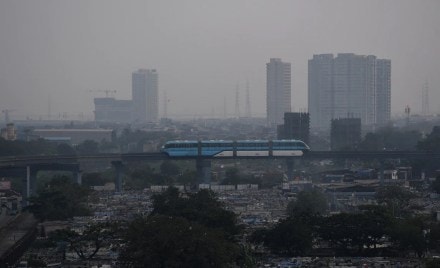Mumbai’s air quality has deteriorated recently with the Air Quality Index (AQI) being above 200 (poor) at several places in the city in the past few days. Air quality in the city worsened nearly two weeks after the end of the monsoon.
At a four-year high mark for October in particulate matter (PM)-10 as well as temperature, Mumbai is reeling under air pollution levels worse than that of Delhi, which is considered one of the most polluted cities in the world.
However, this is not the first time citizens in Mumbai had to breathe more polluted air than Delhiites. Between January 1 and February 17, the AQI in Mumbai remained higher than that of Delhi’s for 12 days. Furthermore, Mumbai’s AQI during last winter registered as ‘poor’ and ‘very poor’ for 66 out of 92 days.
Also Read: As Mumbai chokes, demand for air purifiers zoom
Why has Mumbai’s air quality worsened?
For long, Mumbai was considered largely immune to the issue of air pollution, and the associated problems of haze and smog, thanks to its coastal location. Strong sea breezes would blow dust and other suspended particles away, keeping the city’s air relatively clean.
But the last two years have shown that this geographical advantage no longer offers reliable protection. Last year saw the longest spell of poor air quality in the city, extending from November to January.
It happened again last week as weather changes severely impacted air quality in Mumbai. The city recorded a rise in the temperature with the average daily maximum temperature ranging from 32 to 34 degrees Celsius last week.
“Climate change is adversely affecting the air quality of the Mumbai metropolitan area, including the Mumbai region,” the Mumbai civic body said last week.
The air quality index (AQI) went beyond 300 in some parts of the city. The AQI in Mumbai, which was in the “good category” earlier this month, has since been ranging between the “poor” and “very poor” categories.
Also Read: Mumbai more polluted than Delhi! ‘Maximum City’ records higher PM10 level, minister says mostly dust
There are six AQI categories — good, satisfactory, moderate, poor, very poor, and severe.
According to the AQI scale, the air quality check between 0 and 50 are considered “good”, 51 and 100 are “satisfactory”, 101 and 200 are “moderate”, 201 and 300 are “poor”, 301 and 400 are “very poor”, and 401 and 450 are “severe”.
What steps are being taken to improve Mumbai’s air quality?
The Brihanmumbai Municipal Corporation (BMC) has taken several measures to improve the city’s air quality. To control dust, mist machines have been installed at various locations, including Worli Sea Face, Haji Ali, Peddar Road, Swarajya Bhoomi (Girgaon Chowpatty), Nariman Point, Fashion Street, Badhwar Park, and the World Trade Center.
In view of the alarming air pollution levels in the city, the BMC commissioner Iqbal Singh Chahal held a meeting last week and warned they would stop construction — be it a private site or a government project — if dust and pollution control measures are not being taken.
Sprinkler systems should be provided at all construction sites within 15 days and anti-smog guns should be provided within 30 days, the BMC said.
The civic body is also going to operate anti-smog guns on 50 to 60 major roads.
